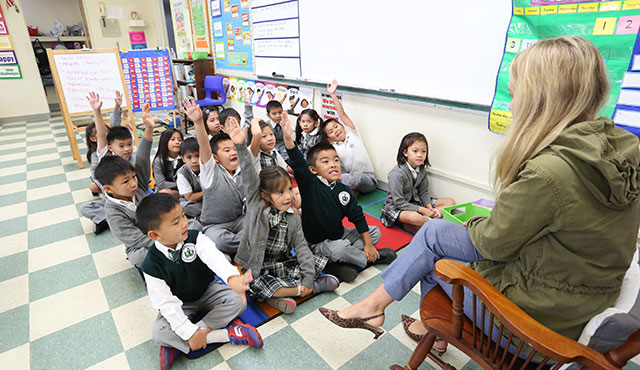The Catholic community holds up its formative education programs as a model for the rest of the nation, and that pride is not unfounded. According to the latest Nation’s Report Card, Catholic school fourth and eighth grade students outperformed their public school counterparts in math and reading.
Also known as the National Assessment of Educational Progress (NAEP), it is administered by the National Center for Education Statistics, within the U.S. Department of Education and the Institute of Education Services. It is the largest nationally representative assessment that measures student achievement levels in various subjects at four-year grade intervals. NAEP data can be found at nces.ed.gov.
The four achievement levels are below basic (less than partial mastery), basic (partial mastery of fundamental skills and knowledge), proficient (solid academic performance) and advanced (superior performance). The scale score of 0-500 is determined by the student test results of all levels of achievement.
In math, Catholic school fourth grade students have a scale score of 245 compared to the public schools’ score of 239. Eighth grade Catholic school students scored 294 compared to their public school counterpart score of 282.
Catholic schools continued to earn high marks in reading as well. Catholic school fourth graders earned a scale score of 235 compared to their public school counterpart score of 221. Catholic school eighth graders earned 283 while public schools scored 265.
So, why do Catholic schools perform better than public schools in national assessments?
For Catholic schools in California, including the Diocese of Orange, one reason could be a result of many of its dioceses adopting the STAR Assessments for reading and math skills and abilities testing needs. Students are assessed in September, January or February and May.
“The results of the test, the data is used at the school, classroom level and at the individual level to adjust instruction as needed to a very individualized level so that students are getting what they need,” said Diocesan Superintendent of Schools Dr. Erin Barisano. “The benefit of giving it three times a year is that the data can be used right then and there to adjust the lesson tomorrow for the kids. It’s the immediacy of the feedback that has been really instrumental in student achievement.”
The data allows teachers to challenge high-performing students and also adjust instruction or provide intervention for students who are struggling in order to bring them up to grade level.
A 2017-2018 report by NCEA (National Catholic Education Association) shows that non-Catholics are recognizing the benefits of a Catholic education. The NCEA conducts Catholic education research and publishes an annual report of statistics that include enrollment, staffing, schools, tuition, student race and ethnicity.
Their enrollment research shows that although there’s been a decline in the U.S. since 2007, non-Catholic enrollment has gone up from 2.7 percent in 1970 to 19 percent today. Catholic schools have worked hard to turn around enrollment numbers.
“One of the great things about our schools is that we were the first diocese to roll out the one-to-one device program at the diocesan level,” said Barisano. “Introducing technology into an already-strong existing curriculum is something that I think today’s parents are really interested in. We have a number of our schools that incorporate blended learning, which utilizes technology as another instructional tool, again to deliver curriculum in a way that is relevant to students and helps prepare them.”
Barisano added, “Another area that is really attractive to parents and something that we will focus on, is really promoting the values-based education that we are founded on, specifically in the context of Catholic schools, the gospel values and our Catholic identity. Ensuring that is at the forefront of everything that we do in a way that is very inclusive of our non-Catholic families and also very clear in our Catholicism.”
Gabriella Karina, the Diocese’s manager for Catholic Schools Enrollment and Marketing, assumed her position in June and began visiting schools to learn more about them. She says her meetings with principals and staff in each school have been an informative experience.
“I think so many times when people think of Catholic education the first thing they think about are the barriers, the finances, but there are, at the same time, so many beautiful stories,” said Karina. “I’d visit a school and the principal is in tears because a student who has special needs, who had been struggling in public school, came to her school and now is doing so well.”
Catholic schools are finding more ways to provide financial aid to students. In the Diocese of Orange, the Orange Catholic Foundation raises funds to provide tuition assistance for families who can’t afford a Catholic education. The foundation has also been generous in providing grants for technology professional development for teachers. The foundation organizes the Conference on Business & Ethics every year and invites business, religious, academic and philanthropic leaders to a forum that reinforces a commitment to ethical practices. This year’s sold-out conference raised $600,000 for elementary tuition assistance.
In addition, schools are developing strong community and alumni relationships whose donations are also helping to build the next generation of Catholic school students.


